A few weeks ago, art gal posted a link about an exhibit at the National Portrait Gallery in Washington, D.C. entitled “Hide/Seek: Difference and Desire in American Portraiture.” This exhibit, which opened just last month, is the first of its kind to focus specifically on the representation of gay and lesbian identity and its impact on the arts in American history and culture. This week, the exhibit has come under fire by a couple of a top-ranking state Representatives
(John Boehner (R-Ohio) and Eric Cantor (R-Va.)) as well as members of the public who are calling for the cancellation of the exhibition altogether.
As a result, the NPG has pulled from the exhibit a four-minute edited version of a video by artist David Wojnarowicz (
A Fire in my Belly, 1987) which shows, among other things, a small crucifix with ants crawling on it as well as a nude male body. Contemporary art is certainly no stranger to this kind of controversy. This latest exhibit is only the most recent example of a long line of debates concerning the public display (and public funding) of works of art that provoke, offend, and otherwise disturb the aesthetic (or even "moral") sensibilities of segments of the population. The previous 25 years provide us with a litany of now-iconic artworks and their resulting controversies: Dred Scott's
What is the Proper Way to Display the American Flag? and its contested display at the School of the Art Institute in Chicago; Robert Mapplethorpe's
X Portfolio, which led to the arrest of Cincinnati Contemporary Art Center's director in 1990 on charges of obscenity and the Corcoran (also in D.C.) Gallery's decision to cancel its scheduled exhibit; Andres Serrano's
Piss Christ and the debate over NEA artist funding; and the 1999 controversy over
Sensation, which led to the temporary suspension of state funding to the Brooklyn Museum.
Controversies like these re-ignite ongoing debates about the role and/or responsibility of art and artists in society, the role of the state in supporting contemporary art, and the boundaries of social, aesthetic, and ethical propriety. What about the role and/or responsibility of the art museum as a public institution? As members of an art community, what are your thoughts on the subject? How do you respond to provocative, or even offensive, works of art? How do we reconcile and respond to accusations of "shock" that often reduce these works of art to meaningless "garbage"? How can we, as a society, still find meaning and value in works of art that are difficult to digest?
Here are a couple of links, one to
an article about the current controversy and the other is to an
op-ed peiece in the Washington Times. I'd love to hear others, especially students, weigh in on this topic.


















































